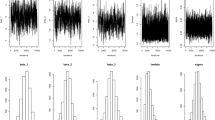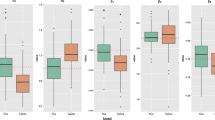Abstract
Empirical studies in various fields, such as clinical trials, environmental sciences, psychology, as well as finance and economics, often encounter the task of conducting statistical inference for longitudinal data with ordinal responses. In such situation, it may not be valid of using the orthodox modeling methods of continuous responses. In addition, most traditional methods of modeling longitudinal data tend to depict the average variation of the outcome variable conditionally on covariates, which may lead to non-robust estimation results. Quantile regression is a natural alternative for describing the impact of covariates on the conditional distributions of an outcome variable instead of the mean. Furthermore, in regression modeling, excessive number of covariates may be brought into the models which plausibly result in reduction of model prediction accuracy. It is desirable to obtain a parsimonious model that only retains significant and meaningful covariates. Regularized penalty methods have been shown to be efficient for conducting simultaneous variable selection and coefficient estimation. In this paper, Bayesian bridge-randomized penalty is incorporated into the quantile mixed effects models of ordinal longitudinal data to conduct parameter estimation and variable selection simultaneously. The Bayesian joint hierarchical model is established and an efficient Gibbs sampler algorithm is employed to perform posterior statistical inference. Finally, the proposed approach is illustrated using simulation studies and applied to an ordinal longitudinal real dataset of firm bond ratings.
Similar content being viewed by others
References
Aghamohammadi A, Mohammadi S (2017) Bayesian analysis of penalized quantile regression for longitudinal data. Stat Pap 58(4):1035–1053
Albert J, Chib S (1993) Bayesian analysis of binary and polychotomous response data. J Am Stat Assoc 88:669–679
Alhamzawi R, Algamal ZY (2018) Bayesian bridge quantile regression. Commun Stat Simul Comput. https://doi.org/10.1080/03610918.2017.1402042
Alhamzawi R, Ali HTM (2018a) Bayesian quantile regression for ordinal longitudinal data. J Appl Stat 45(5):815–828
Alhamzawi R, Ali HTM (2018b) Bayesian single-index quantile regression for ordinal data. Commun Stat Simul Comput. https://doi.org/10.1080/03610918.2018.1494283
Alhamzawi R, Ali HTM (2018c) Bayesian Tobit quantile regression with \(L_{1/2}\) penalty. Commun Stat Simul Comput 47(6):1739–1750
Alhamzawi R, Yu K, Benoit DF (2012) Bayesian adaptive Lasso quantile regression. Stat Model 12(3):279–297
Betancourt B, Rodriguez A, Boyd N (2017) Bayesian fused Lasso regression for dynamic binary networks. J Comput Graph Stat 26(4):840–850
Bresson G, Lacroix G, Rahman MA (2020) Bayesian panel quantile regression for binary outcomes with correlated random effects: an application on crime recidivism in Canada. Empir Econ. https://doi.org/10.1007/s00181-020-01893-5
Davino C, Furno M, Vistocco D (2014) Quantile regression: theory and applications. Wiley, New York
Demidenko E (2013) Mixed models: theory and applications with R (2nd Edition). Wiley, Hoboken
Diggle PJ, Heagerty P, Liang KY, Zeger SL (2002) Analysis of longitudinal data, 2nd edn. Oxford University Press, Oxford
Fan J, Li R (2001) Variable selection via nonconcave penalized likelihood and its oracle properties. J Am Stat Assoc 96(456):1348–1360
Fu WJ (1998) Penalized regresssion: the bridge versus lasso. J Comput Graph Stat 7(3):397–416
Gefan D (2014) Bayesian doubly adaptive elastic-net Lasso for VAR shrinkage. Int J Forecast 30(1):1–11
Geraci M, Bottai M (2007) Quantile regression for longitudinal data using the asymmetric Laplace distribution. Biostatistics 8(1):140–154
Ghasemzadeh S, Ganjali M, Baghfalaki T (2018a) A Bayesian conditional model for bivariate mixed ordinal and skew continuous longitudinal responses using quantile regression. J Appl Stat 45(14):2619–2642
Ghasemzadeh S, Ganjali M, Baghfalaki T (2018b) Bayesian quantile regression for analyzing ordinal longitudinal responses in the presence of non-ignorable missingness. Metron 76(3):321–348
Ghasemzadeh S, Ganjali M, Baghfalaki T (2020) Bayesian quantile regression for joint modeling of longitudinal mixed ordinal and continuous data. Commun Stat Simul Comput 49(2):375–395
Huang J, Horowitz JL, Ma S (2008) Asymptotic properties of bridge estimators in sparse high-dimensional regression models. Ann Stat 36(2):587–613
Jeliazkov I, Graves J, Kutzbach M (2008) Fitting and comparison of models for multivariate ordinal outcomes. Adv Econom Bayesian Econom 23:115–156
Knight K, Fu WJ (2000) Asymptotics for LASSO-type estimators. Ann Stat 28(5):1356–1378
Kobayashi G, Kozumi H (2013) Bayesian analysis of quantile regression for censored dynamic panel data. Comput Stat 27:359–380
Koenker R (2005) Quantile regression. Cambridge University Press, Cambridge
Koenker R, Bassett J (1978) Regression quantiles. Econometrica 46(1):33–50
Kozumi H, Kobayashi G (2011) Gibbs sampling methods for Bayesian quantile regression. J Stat Comput Simul 81(11):1565–1578
Laffont CM, Vandemeulebroecke M, Concordet D (2014) Multivariate analysis of longitudinal ordinal data with mixed effects models, with application to clinical outcomes in osteoarthritis. J Am Stat Assoc 109(507):955–966
Laird NM, Ware JH (1982) Random-effects models for longitudinal data. Biometrics 38(4):963–74
Liu LC (2008) A model for incomplete longitudinal multivariate ordinal data. Stat Med 27(30):6299–6309
Liu LC, Hedeker D (2006) A mixed effects regression model for longitudinal multivariate ordinal data. Biometrics 62(1):261–268
Mallick H, Yi N (2018) Bayesian bridge regression. J Appl Stat 45(6):988–1008
Montesinos-Lopez OA, Montesinos-Lopez A, Crossa J, Burgueno J, Eskridge K (2015) Genomic-enabled prediction of ordinal data with Bayesian logistic ordinal regression. Genom Sel 5(10):2113–2126
Park T, Casella G (2008) The Bayesian lasso. J Am Stat Assoc 103(482):681–686
Polson NG, Scott JG, Windle J (2014) The Bayesian bridge. J R Stat Soc Ser B 76(4):713–733
Rahman MA (2016) Bayesian quantile regression for ordinal models. Bayesian Anal 11(1):1–24
Rahman MA, Karnawat S (2019) Flexible Bayesian quantile regression in ordinal models. Adv Econom 40B:211–251
Rahman MA, Vossmeyer A (2019) Estimation and applications of quantile regression for binary longitudinal data. Adv Econom 40:157–191
Razie F, Samani EB, Ganjali M (2017) Latent variable model for mixed correlated power series and ordinal longitudinal responses with non ignorable missing values. Commun Stat Theory Methods 46(12):5738–5753
Reich BJ, Fuentes M, Dunson DB (2011) Bayesian spatial quantile regression. J Am Stat Assoc 106:6–20
Sorensen DA, Andersen S, Gianola D, Korsgaard I (1995) Bayesian inference in threshold models using Gibbs sampling. Genet Sel Evol 27(3):229–249
Stohs MH, Mauer DC (1996) The determinants of corporate debt maturity structure. J Bus 69(3):279–312
Tian YZ, Li EQ, Tian MZ (2016) Bayesian joint quantile regression for mixed effects models with censoring and errors in covariates. Comput Stat 31(3):1–27
Tian YZ, Shen SL, Lu G, Tang ML, Tian MZ (2019) Bayesian LASSO-regularized quantile regression for linear regression models with autoregressive errors. Commun Stat Simul Comput 48(3):777–796
Tibshirani R (1996) Regression shrinkage and selection via the Lasso. J R Stat Soc Ser B 73(1):273–282
Todem D, Kim K, Lesaffre E (2009) Latent-variable models for longitudinal data with bivariate ordinal outcomes. Stat Med 26(5):1034–1054
Ursino M, Gasparini M (2016) A new parsimonious model for ordinal longitudinal data with application to subjective evaluations of a gastrointestinal disease. Stat Methods Med Res. https://doi.org/10.1177/0962280216661370
Varin C, Czado C (2010) A mixed autoregressive probit model for ordinal longitudinal data. Biostatistics 11(1):127–138
Wu L (2010) Mixed effects models for complex data. Chapman Hall/CRC Press, Boca Raton
Wu H, Zhang JT (2006) Nonparametric regression methods for longitudinal data analysis: mixed-effects modeling approaches. Wiley, New York
Xu Z, Zhang H, Wang Y, Chang X, Liang Y (2010) \(L_{1/2}\) regularization. Sci China Inf Sci 53(6):1159–1169
Xu Z, Chang X, Xu F (2012) \(L_{1/2}\) regularization: a thresholding representation theory and a fast solver. IEEE Trans Neural Netw Learn Syst 23(7):1013–1027
Yang H, Chen ZJ, Zhang WP (2019) Bayesian nonlinear quantile regression approach for longitudinal ordinal data. Commun Math Stat 7:123–140
Yu K, Moyeed RA (2001) Bayesian quantile regression. Stat Probab Lett 54(4):437–447
Zhao KF, Lian H (2015) Bayesian Tobit quantile regression with single-index models. J Stat Comput Simul 85(6):1247–1263
Zou H (2006) The adaptive LASSO and its oracle properties. J Am Stat Assoc 101(476):1418–1429
Zou H, Hastie T (2005) Regularization and variable selection via the elastic net. J R Stat Soc Ser B 67(2):301–320
Acknowledgements
The authors thank editors and two reviewers for their constructive comments and valuable suggestions which have greatly improved the paper. The work of Man-Lai Tang was partially supported through grants from the Research Grant Council of the Hong Kong Special Administrative Region [UGC/FDS14/P01/16, UGC/FDS14/P02/18 and The Research Matching Grant Scheme (RMGS)] and a grant from the National Natural Science Foundation of China (Grant 11871124). The computing facilities/software were supported from SAS Viya and the Big Data Intelligence Centre at the Hang Seng University of Hong Kong. The research of Yu-Zhu Tian was partially supported by grants from the National Natural Science Foundation of China (Grants 12061065, 11861042).
Author information
Authors and Affiliations
Corresponding author
Additional information
Publisher's Note
Springer Nature remains neutral with regard to jurisdictional claims in published maps and institutional affiliations.
Rights and permissions
About this article
Cite this article
Tian, YZ., Tang, ML., Chan, WS. et al. Bayesian bridge-randomized penalized quantile regression for ordinal longitudinal data, with application to firm’s bond ratings. Comput Stat 36, 1289–1319 (2021). https://doi.org/10.1007/s00180-020-01037-4
Received:
Accepted:
Published:
Issue Date:
DOI: https://doi.org/10.1007/s00180-020-01037-4




